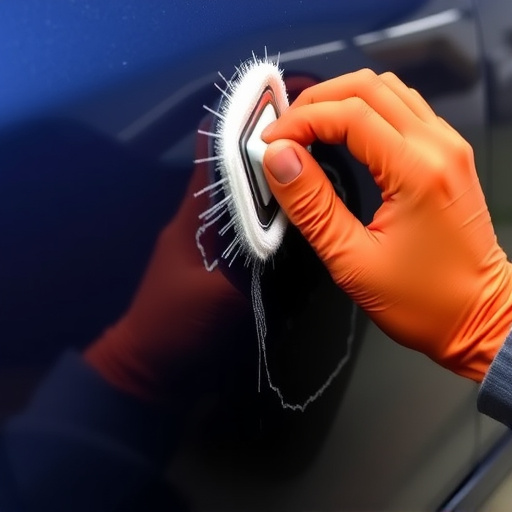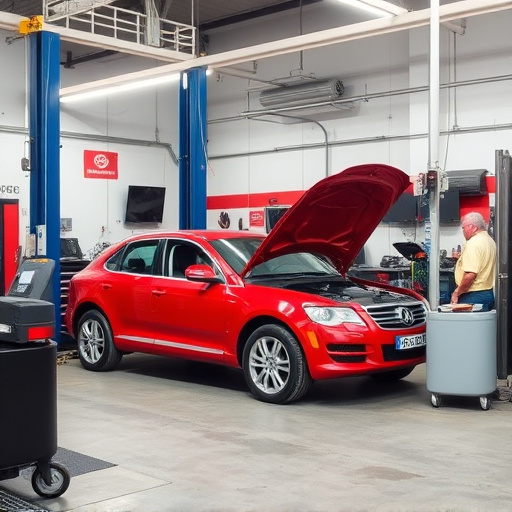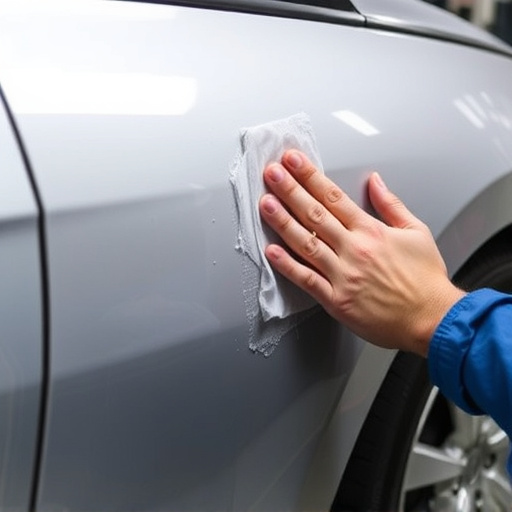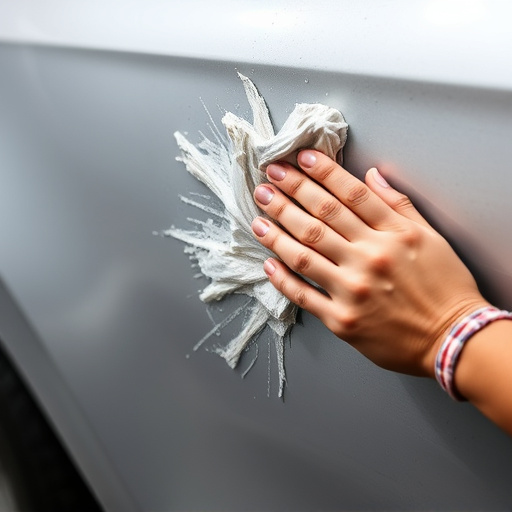Uncovering Collision Repair Estimate Variations Through Shop Certifications

Shop certifications for collision repair are crucial when comparing estimates, as they guarantee pro…….
Collision repair estimates are a critical component of the automotive industry, serving as a bridge between accident scenarios and the restoration process. This article aims to explore every facet of collision repair estimates, from their foundational understanding to their global impact, technological advancements, and future prospects. By delving into this complex topic, we will equip readers with valuable insights, enabling them to grasp the significance of accurate and efficient collision repair estimates in today’s fast-paced world.
Collision repair estimates refer to the detailed calculations and projections prepared by automotive experts, typically body shop owners or insurance assessors, to determine the cost of repairing damaged vehicles following a collision. These estimates encompass a comprehensive breakdown of parts replacements, labor costs, and miscellaneous expenses, offering a clear financial roadmap for the restoration process.
Core Components:
Parts Costs: Identifies specific vehicle components that require replacement or repair, accompanied by their respective prices.
Labor Rates: Details the estimated time required to complete repairs, translated into labor rates per hour or per task.
Miscellaneous Fees: Includes costs for diagnostics, rental cars, and other indirect expenses associated with the repair process.
Total Estimate: The cumulative cost derived from the parts and labor components, providing a final figure for the vehicle’s restoration.
The practice of collision repair estimates has evolved over decades to keep pace with technological advancements in both vehicles and repair techniques. Initially, these estimates relied heavily on manual calculations and industry-standard guidelines. However, the advent of computer-aided design (CAD) software and digital parts databases has revolutionized the process, enabling faster, more precise assessments.
Collision repair estimates play a pivotal role in several key areas:
Insurance Claims: Insurers use these estimates to determine fair compensation for policyholders’ damaged vehicles.
Body Shop Operations: They guide body shops in pricing services, resource allocation, and project management.
Vehicle Restoration: Estimates ensure that repairs are executed efficiently, using genuine parts, and within agreed-upon timelines.
Collision repair estimates have a profound global impact, with variations stemming from regional automotive industries, labor costs, and insurance systems. For instance:
North America: Known for its robust automotive market, the US and Canada have well-established estimate guidelines and digital tools, ensuring consistent pricing.
Europe: With diverse markets like Germany and Italy, European collision repair estimates reflect varying part availability, labor rates, and regulatory standards.
Asia Pacific: Rapidly growing economies in this region are witnessing an increase in vehicle ownership, leading to heightened demand for efficient and affordable collision repair services.
Several trends are influencing the global collision repair estimates landscape:
Digital Transformation: The adoption of advanced software, such as CAD systems and cloud-based estimate platforms, is streamlining the estimation process and enhancing accuracy.
Real-Time Data Access: Online databases and part suppliers’ digital catalogs enable estimators to access up-to-date pricing information, ensuring estimates remain current.
Global Standardization: International organizations are working towards harmonizing collision repair estimate formats and methodologies, facilitating cross-border insurance claims.
The global collision repair industry is a significant economic contributor, with revenue generated from both direct repairs and related services:
Direct Repairs: Involve the physical restoration of damaged vehicles, accounting for most industry revenue.
Related Services: Include towing, rental cars, and supplementary repairs, adding to the overall market size.
Collision repair estimates are a critical factor in investment decisions within the industry:
Body Shop Expansion: Accurate estimates attract investors by demonstrating the profitability of expanding body shop operations.
Technology Upgrades: The demand for advanced estimation tools drives investments in software development and digital infrastructure.
The collision repair estimates sector is integral to economic systems worldwide:
Employment: Supports a substantial number of jobs, from estimators to skilled technicians, contributing to unemployment rates.
Gross Domestic Product (GDP): Direct and indirect contributions to the automotive industry and related sectors boost GDP.
Technological advancements in collision repair estimates have been pivotal:
CAD Software: Enables digital design of vehicle damage, facilitating precise part identification and cost calculation.
Online Estimate Platforms: Cloud-based systems allow estimators to access comprehensive databases, generate reports, and collaborate remotely.
Artificial Intelligence (AI): AI algorithms analyze historical data to predict parts costs, labor times, and potential repair challenges, enhancing estimate accuracy.
Technological innovations have led to:
Faster Estimates: Digital tools reduce manual calculation time, allowing estimators to process more claims efficiently.
Enhanced Accuracy: Advanced software minimizes human error, ensuring estimates align closely with actual repair costs.
The future holds immense potential for technology in collision repair estimates:
Virtual Reality (VR): VR simulations could revolutionize training and allow estimators to virtually inspect vehicles, even those located remotely.
Blockchain: This distributed ledger technology has the potential to enhance data security, streamline claims processing, and create a transparent parts supply chain.
Collision repair estimates are subject to various policies and regulations that vary by region:
Insurance Regulations: Governments enforce rules on how insurers should handle collision repair estimates, ensuring fairness for policyholders.
Labor Laws: These govern the rights and compensation of technicians involved in vehicle repairs, impacting estimate-related decisions.
Environmental Standards: Regulations dictate the disposal and recycling of vehicle parts, influencing cost calculations.
Policies and regulations play a crucial role in shaping:
Industry Standards: Setting minimum standards for estimate preparation and repair quality ensures consistency across the industry.
Consumer Protection: Regulatory oversight safeguards consumers against unfair practices, ensuring they receive accurate and just compensation.
Despite its advancements, collision repair estimates face several challenges:
Data Inconsistencies: Part prices and labor rates can vary widely between regions and suppliers, creating inconsistencies in estimates.
Complex Damage Scenarios: Vehicles with intricate designs or specialized components may require unique repairs, posing challenges to accurate estimating.
Skills Shortage: The industry faces a shortage of skilled estimators and technicians, impacting service quality and estimate accuracy.
Criticisms of collision repair estimates include:
Overestimation/Underestimation: Critics argue that estimates may not always align with actual repair costs, leading to disputes.
Solution: Implementing AI-driven predictive analytics can minimize this issue by factoring in historical data trends.
Lack of Standardization: Regional variations in estimate formats create challenges for cross-border insurance claims.
Solution: International collaborations should focus on harmonizing estimate guidelines to facilitate smoother claims processing.
Ethical Concerns: Accurate estimates are essential, but they must also protect consumers from unfair practices.
Solution: Strict regulatory oversight and consumer education can foster trust in the industry.
Scenario: A major European insurance company implemented a cloud-based estimate platform to streamline its collision repair process.
Results: The digital transformation led to:
Context: A US-based body shop adopted AI algorithms for part cost prediction and labor time estimation.
Outcomes:
Initiative: An Asian insurance consortium explored blockchain technology to ensure the authenticity of vehicle parts used in collision repairs.
Benefits:
The collision repair estimates sector is poised for significant growth:
Emerging Markets: Rapidly industrializing nations in Asia and Latin America present vast opportunities due to increasing vehicle ownership.
Autonomous Vehicles: As self-driving cars become mainstream, estimate processes will evolve to account for unique damage scenarios and replacement part requirements.
Sustainable Mobility: The rise of electric vehicles (EVs) introduces new challenges and opportunities, as collision repair estimates must incorporate specialized EV components.
Several emerging trends are shaping the future:
Real-Time Estimating: AR/VR technologies will enable estimators to virtually inspect damaged vehicles, providing real-time estimates.
Digital Twin Technology: Creating digital replicas of vehicles could streamline repairs by offering precise reference data for estimates and technician training.
Predictive Analytics Integration: Advanced AI models will anticipate future trends in vehicle damage, repair costs, and part availability, enhancing estimate accuracy.
Collision repair estimates are a dynamic and critical aspect of the automotive industry, constantly evolving to meet global demands and technological advancements. From historical manual calculations to today’s digital and AI-driven processes, these estimates have become essential tools for efficient vehicle restoration and fair insurance claims. As the industry navigates emerging trends and challenges, accurate collision repair estimates will remain a cornerstone of sustainable mobility and consumer protection.
Q: How do I know if my collision repair estimate is accurate?
A: Accuracy depends on several factors, including the estimator’s expertise, the tools used, and data availability. Look for detailed breakdowns, transparent pricing, and comparisons with similar vehicles to verify the estimate’s validity.
Q: Can technology completely replace human estimators?
A: While technology significantly enhances efficiency and accuracy, human judgment remains invaluable. Estimators interpret damage patterns, consider unique vehicle characteristics, and make real-world assessments that machines may struggle to replicate.
Q: How do I handle a dispute with my insurance company over an estimate?
A: If you disagree with an estimate, request a detailed breakdown of costs from the insurer. You can also consult with your insurance provider’s appraiser or seek a second opinion from another body shop. Maintaining records and communication is crucial during this process.
Q: What role does blockchain technology play in collision repair estimates?
A: Blockchain ensures transparency and security, allowing insurers, estimators, and parts suppliers to access an immutable record of vehicle repairs, parts transactions, and costs. This reduces fraud and enhances trust within the ecosystem.

Shop certifications for collision repair are crucial when comparing estimates, as they guarantee pro…….

After a car collision, get multiple collision repair estimates from different auto body shops to com…….

Collision repair estimates offer a transparent view of vehicle restoration costs, detailing parts, l…….

Understanding deductibles is crucial when reviewing collision repair estimates as they represent out…….

The age, make and model, and damage type of a vehicle significantly impact collision repair estimate…….

Transparency in collision repair estimates empowers customers, fosters trust, and enhances satisfact…….

Know your rights when seeking collision repair estimates. Compare shops based on detailed, transpare…….

OEM parts are crucial for accurate collision repair estimates due to precise fitment, superior quali…….

Local laws regulate collision repair estimates, ensuring transparency and consumer protection. Shops…….

Hidden vehicle damage, crucial for accurate collision repair estimates, often goes unnoticed. Profes…….